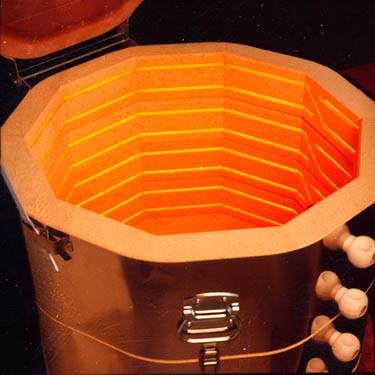 Kilns have taken many different forms over their long existence and continue to evolve. They have ranged from pits dug in the ground fired with dung to commercial kilns the size of football fields.
Kilns have taken many different forms over their long existence and continue to evolve. They have ranged from pits dug in the ground fired with dung to commercial kilns the size of football fields.
Relatively new in the long history of kilns, electric kilns have become the most popular kilns used by hobbyists and schools. This is primarily due to their ease of use, consistent results, low cost, and low emissions. There are many designs for wood and gas fired kilns used by advanced artists and industry. Since this site is focused on getting started we are going to discuss electric kilns only.
There are many shapes and sizes but the first characteristic most people use to distinguish them is their purpose.
Ceramic Kilns
 The most popular kilns used today by artists are powered by electricity and range in size from small units that can sit on your countertop to units the size of your refrigerator.
The most popular kilns used today by artists are powered by electricity and range in size from small units that can sit on your countertop to units the size of your refrigerator.
Ceramic kilns are generally defined by their temperature rating. The most common commercial ceramic glazes and clay are fired between 1828 F and 2345 F. The materials used in a ceramic kiln need to be carefully chosen and designed to not only reach those temperatures but also hold up to that harsh environment overtime.
Ceramic kilns will almost always only have elements in the side walls of the kiln. There are two reasons for this. When elements get over 1800 F they began to get soft like cooked spaghetti and therefore need to by supported by grooves cut into the brick of the side walls of the kiln. Another reason ceramic kilns are generally side firing is because artists generally fire multiple levels of ware in their kiln. The elements in the kiln can radiate between the shelves when mounted in the side.
The most common design is a cylindrical top loading shape. This shape is the most economical way to build a kiln so they tend to be less expensive then square front loading kilns (like a refrigerator).
Glass Kilns
There are many different types of glass kilns. Some are used by glass blowers to fully melt the glass so it can be blown into shapes others are strictly designed to anneal the glass. The most popular glass kilns found in the home are used to fuse a slump glass. Often times these kilns will have elements in the lid.
Unlike ceramic kilns, glass kilns are rarely fired over 1700 degrees so it is possible to pin the elements in the lid of the kiln so they can radiate evenly across the top of the piece being fused or slumped. Large glass pieces are sensitive to temperature variations within the piece while it is being heated and cooled so top firing helps to eliminate this variation. This does not mean you cannot successfully fire glass in side-heated kilns, you just need to fire a little slower.
There are many different shapes and sizes of glass kilns. Artists working with very large pieces may prefer a large oval or rectangular design whereas a glass jewelry maker prefers a small table top design. Some glass kilns are designed for easy access so the artists can manipulate the glass while it is hot.
Metal Clay
Due to the expense of the material most metal clay projects are relatively small so the kilns used by these artist tend to be small table-top models. They can either be top or front-loading units and they are generally rated up to around 1800 F.
You can fire metal clay in any kiln that reaches the temperatures required however most people prefer not to use a large ceramic or glass kiln to fire a few small jewelry items.
Bronze and copper metal clay require you to use a small crucible kiln filled with material that burns to create a reduction atmosphere. It is important to use this crucible to contain the smoke that is created during the firing so the soot does not deposit on your elements and cause them to degrade. Make sure you choose a kiln large enough to hold the crucible you have chosen.



